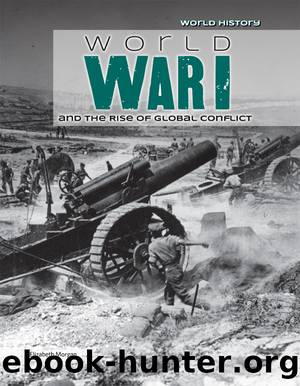World War I and the Rise of Global Conflict by Morgan Elizabeth;Green Robert;

Author:Morgan, Elizabeth;Green, Robert; [Morgan, Elizabeth]
Language: eng
Format: epub
Publisher: Greenhaven Publishing LLC
When Rennenkampf heard the news from the Battle of Tannenberg, he moved south to assist Samsonov, but it was too late. The Russian Second Army had been cut in half in one battle. The Germans captured approximately 92,000 Russian soldiers, and more than 30,000 were killed or wounded. Samsonov shot himself instead of returning to Russia in disgrace.
The Battle of Tannenberg tipped the balance in favor of the Germans on the northern section of the eastern front. The Russians fared better on the southern section of the front. The Russians launched the second half of their 1914 offensive against the Austro-Hungarian Empire, which shared a long border with lands controlled by Russia. The Russians struck at an area known as Galicia, which is split between Ukraine and Poland on current maps. Once an ancient kingdom, most of Galicia was controlled by Austria-Hungary at the outset of World War I.
In August, the Austro-Hungarians struck first, driving into Poland and throwing the Russians on the defensive. The situation, however, was quickly reversed, and the Russians drove the Austro-Hungarians out of Poland and into Galicia. The Russians neatly trapped a large enemy army, just as the Germans had done to them at Tannenberg. However, the Russian advance ground to a halt due to a lack of supplies and poor organization.
Despite the lack of organization, this southern Russian advance proved to be an initial success and took pressure off Russian troops farther north on the eastern front, since the Germans moved troops south to help their ally defend against a Russian invasion. Once German troops arrived, however, the situation reversed. The Central Powers flung the Russians back. The fighting on the eastern front concentrated on Galicia for the rest of the war.
Russian Weaknesses and Strengths
In spring 1915, the Central Powers mounted an offensive in the region against worn Russian troops. The attack caused enormous losses for the Russians and exhibited movement unseen on the western front since the beginning of the war. The Germans fought on two fronts, nearly breaking Allied armies on both. The Russians found themselves deprived of the war mateÌriel, or equipment, they needed to defend against the German advance, especially field artillery and aircraft. âAt the beginning of the war,â wrote a Russian officer, âwe had guns, ammunition, and rifles, we were victorious. When the supply of munitions and arms began to give out, we still fought brilliantly. Today ⦠our army is drowning in its own blood.â34
Russia may have lacked industrial supplies, but it did not lack manpower. Russia had the largest population of the nations at war. The size of the Russian army made up in part for its lack of artillery and other advanced weapons. At no time was this more evident than during the Brusilov Offensive of 1916.
INFLUENCING RUSSIAN POLITICS
Russia bubbled with secret plots and conspiracies during World War I. While the war continued in the open, a political war was conducted in secret. Bolsheviks, or members of the Russian Social-Democratic Workersâ Party, and revolutionaries of
Download
This site does not store any files on its server. We only index and link to content provided by other sites. Please contact the content providers to delete copyright contents if any and email us, we'll remove relevant links or contents immediately.
Pale Blue Dot by Carl Sagan(4613)
Cracking the GRE Premium Edition with 6 Practice Tests, 2015 (Graduate School Test Preparation) by Princeton Review(4039)
Pocahontas by Joseph Bruchac(4024)
Unfiltered by Lily Collins(3908)
The Emotionary: A Dictionary of Words That Don't Exist for Feelings That Do by Eden Sher(3221)
The Daily Stoic by Holiday Ryan & Hanselman Stephen(3106)
Factfulness_Ten Reasons We're Wrong About the World_and Why Things Are Better Than You Think by Hans Rosling(3045)
The President Has Been Shot!": The Assassination of John F. Kennedy by Swanson James L(2969)
Sapiens and Homo Deus by Yuval Noah Harari(2839)
Rogue Trader by Leeson Nick(2823)
The 48 laws of power by Robert Greene & Joost Elffers(2801)
The Rape Of Nanking by Iris Chang(2645)
Almost Adulting by Arden Rose(2584)
Gettysburg by Iain C. Martin(2574)
The Innovators: How a Group of Hackers, Geniuses, and Geeks Created the Digital Revolution by Walter Isaacson(2480)
500 Must-Know AP Microeconomics/Macroeconomics Questions(2475)
The Plant Paradox by Dr. Steven R. Gundry M.D(2424)
In the Woods by Tana French(2407)
Make by Mike Westerfield(2199)
